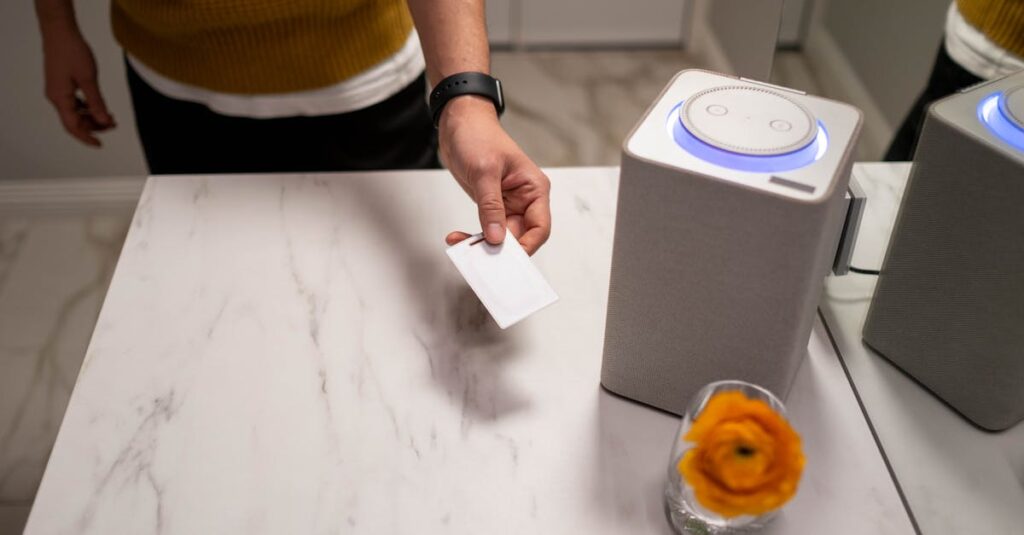Imagine waking up in the morning and having a personal assistant ready to brew your coffee, play your favorite tunes, and even remind you to take out the trash—all without you lifting a finger. Smart home voice assistants have transformed this dream into reality, turning homes into tech-savvy havens. They’re like the friendly robot sidekick you never knew you needed, always ready to lend a hand (or a voice).
Table of Contents
ToggleOverview Of Smart Home Voice Assistants
Smart home voice assistants have emerged as integral tools in modern households. Devices like Amazon Alexa, Google Assistant, and Apple Siri offer users seamless control over smart home devices. These assistants interpret voice commands and execute tasks efficiently, contributing to enhanced home automation.
They support various functionalities, including controlling lighting, adjusting thermostats, and managing security systems. Users benefit from personalized responses, which adapt to individual preferences and routines. Voice assistants also connect with third-party applications to increase their versatility.
Interactivity stands out as a key feature of these assistants. By providing information such as weather updates, news briefings, and reminders, they help streamline daily activities. Families often rely on these devices for scheduling, cooking assistance, and entertainment options.
Security remains a top priority for users. Most voice assistants come with built-in features that safeguard personal data. Encrypted communication and privacy controls are essential aspects that users can customize.
Accessibility options enhance usability for various demographics. Voice assistants accommodate those with disabilities, making everyday tasks more manageable. Several devices include multilingual support, allowing users from different backgrounds to engage with technology more comfortably.
Smart home voice assistants also undergo continuous updates. Manufacturers regularly introduce new features and services to enhance user experience. The evolution of artificial intelligence ensures that these devices become smarter over time, anticipating user needs and improving overall efficiency.
Market data reveals a growing trend toward smart home voice assistants. According to recent statistics, approximately 65% of households incorporate at least one voice-controlled device. This widespread adoption reflects the increasing reliance on technology to simplify everyday life.
Key Features And Capabilities
Smart home voice assistants deliver numerous features that simplify daily living. They offer advanced capabilities that enhance user experience through intuitive interactions.
Voice Recognition Technology
Voice recognition technology enables accurate understanding of spoken commands. These systems utilize machine learning algorithms, improving their performance over time. Users benefit from personalized voice responses tailored to individual preferences. Devices like Amazon Alexa, Google Assistant, and Apple Siri continuously adapt to diverse accents and speech patterns. Accuracy rates often exceed 90%, allowing for natural conversations. Smart assistants can also differentiate between multiple users, enhancing privacy and personalization. Ongoing improvements ensure these technologies remain relevant, meeting the evolving needs of households.
Compatibility With Smart Devices
Compatibility with smart devices stands as a crucial feature of voice assistants. Many smart home devices, including lights, thermostats, and security systems, integrate seamlessly via Wi-Fi or Zigbee. This interconnectedness facilitates centralized control, making home management effortless. Users can issue commands to adjust the home environment, streamlining daily routines. Approximately 85% of smart home devices are compatible with popular voice assistants, highlighting their versatility. Regular updates from manufacturers increase compatibility with new devices, ensuring expanded functionality. As technology advances, this integration continues to enhance the efficiency of smart home ecosystems.
Popular Smart Home Voice Assistants
Smart home voice assistants enhance daily living through convenient features. These systems include Amazon Alexa, Google Assistant, and Apple Siri, which play vital roles in many households.
Amazon Alexa
Amazon Alexa leads the smart home voice assistant market. This platform supports thousands of compatible smart devices, making it versatile for users. Voice commands allow seamless control of home automation, from adjusting lighting to playing music. Advanced functionalities include routines that automate multiple tasks with a single phrase. Approximately 70,000 skills enhance its capabilities, offering everything from recipes to workout instructions. Alexa’s personalization adapts to user preferences, providing tailored suggestions based on past interactions.
Google Assistant
Google Assistant stands out for its powerful search capabilities. Its integration with Google services produces quick and accurate responses to queries. Users can control smart home devices using voice commands effortlessly, streamlining daily tasks. Approximately 90% of smart devices align with Google Assistant, enabling centralized management. This assistant supports multiple users, recognizing distinct voices for personalized experiences. Continuous improvements to its AI ensure it learns and improves over time, delivering an increasingly intuitive user experience.
Apple Siri
Apple Siri excels in integrating with Apple products and services. Users benefit from its seamless connection to iPhones, iPads, and HomePods. Siri can manage smart home devices through HomeKit, allowing for easy control of compatible appliances. Security features include strong privacy controls, ensuring user data remains protected. With context-awareness, Siri responds intelligently based on previous interactions. Approximately 10% of smart home users rely on Apple Siri for their voice assistant needs, showcasing its dedicated loyal user base.
Benefits Of Using Smart Home Voice Assistants
Smart home voice assistants offer significant advantages that transform home living into a more efficient experience. These devices support various functionalities that simplify daily interactions.
Convenience And Hands-Free Control
Hands-free control adds remarkable convenience to daily routines. Users can execute tasks like adjusting lighting or managing music playback without requiring physical interaction. Voice commands simplify operations, from setting alarms to checking schedules. Many households appreciate the ability to multitask, allowing them to control devices while cooking or cleaning. Customizable routines enhance this functionality, triggering multiple actions with a single command. Over 65% of households utilize voice commands for tasks, reinforcing the growing demand for seamless automation.
Enhanced Home Security
Enhanced security features play a critical role in the appeal of smart home voice assistants. Users gain peace of mind through integrated security systems that can monitor homes round the clock. Many devices offer features like live video feeds, smart locks, and alerts via voice commands. Approximately 70% of smart home device users prioritize security capabilities in their voice assistants. Built-in privacy controls ensure personal data is protected, unlocking doors only for authorized individuals. Customizable settings enhance user confidence, allowing them to decide which information to share.
Challenges And Limitations
Smart home voice assistants face several challenges that impact their effectiveness and user trust.
Privacy Concerns
Concerns about privacy frequently arise with smart home voice assistants. Many users worry about data collection practices and how their information is stored. Approximately 70% of users prioritize privacy features when selecting a voice assistant. Manufacturers emphasize security measures like encrypted communication to address these fears. Customizable privacy settings provide users with control over their data, ensuring that only necessary information is shared. Some consumers remain hesitant about using these devices due to potential vulnerabilities that could expose their personal information.
Dependence On Internet Access
Dependence on internet access presents another challenge for smart home voice assistants. These devices rely heavily on connectivity to function effectively. When the internet goes down, so does control over various home automation features. Many users experience frustration during outages since voice commands cannot execute tasks without a stable connection. Approximately 75% of households report occasional internet issues, impacting their smart home experience. Alternative controls, like manual switches, mitigate some inconvenience, but they can’t fully replace the functionality that voice assistants provide.
Smart home voice assistants have undeniably transformed how people interact with their living spaces. By simplifying everyday tasks and enhancing convenience, these devices have become essential tools in modern households. Their ability to integrate with various smart technologies allows users to control their environments effortlessly.
As advancements in artificial intelligence continue, these assistants are set to become even more intuitive and responsive. While challenges such as privacy concerns and dependency on internet connectivity persist, ongoing improvements in security and functionality are addressing these issues. The growing adoption of voice-controlled devices reflects a shift toward a more connected and efficient lifestyle. Embracing these innovations can lead to a more streamlined and enjoyable home experience.





